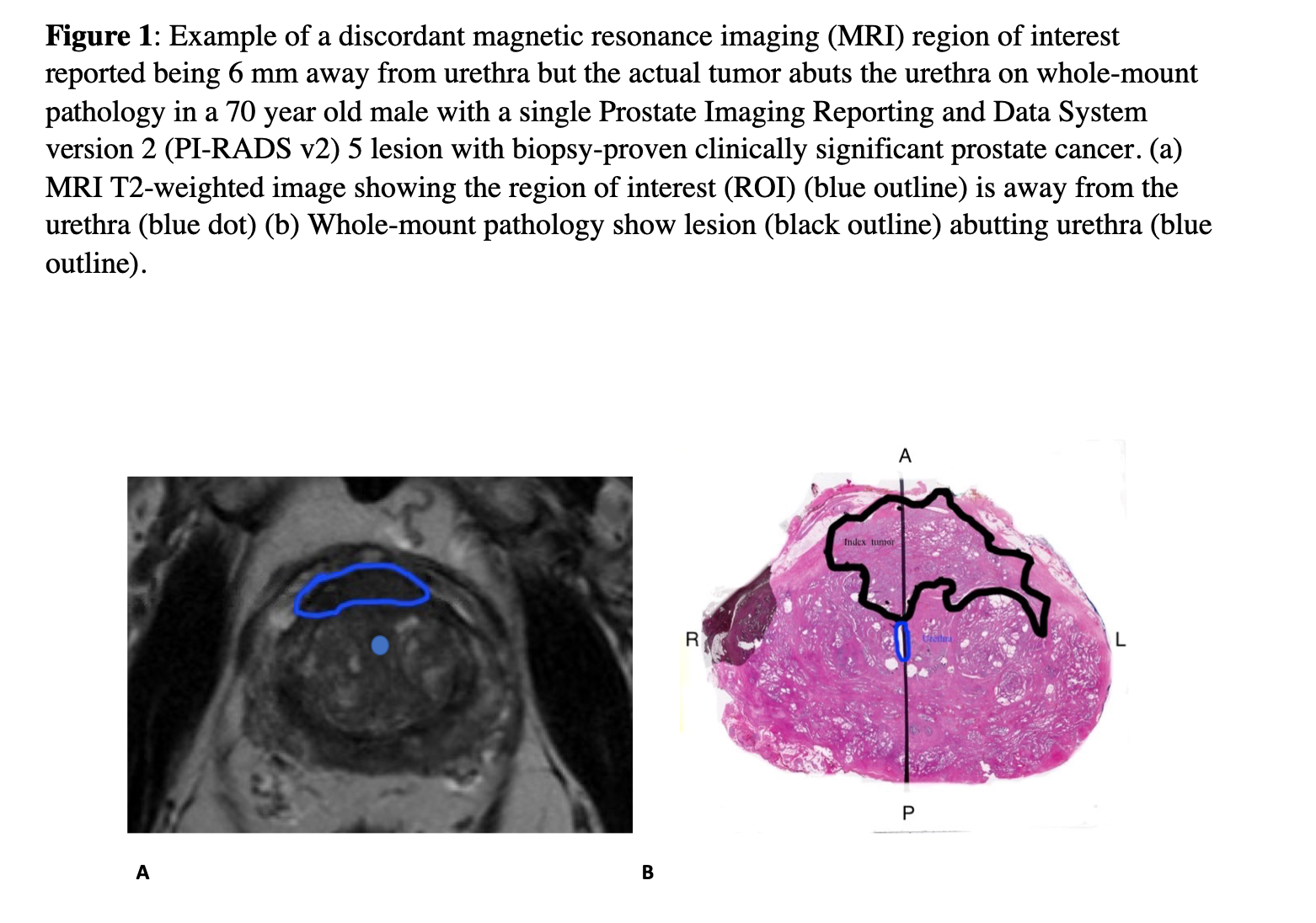Back
Poster, Podium & Video Sessions
Moderated Poster
MP55: Prostate Cancer: Localized: Ablative Therapy
MP55-15: Can MRI localize the proximity of prostate cancer to the urethra in men who are candidates for focal gland ablation?
Monday, May 16, 2022
8:45 AM – 10:00 AM
Location: Room 225
Neal Patel*, Alexa Hughes, Los Angeles, CA, Wayne Brisbane, Gainsville, FL, Ali Rastegarpour, Sohrab Afshari, Lorna Kwan, Anissa V Nguyen, Anthony Sisk, Steven Raman, Robert Reiter, Los Angeles, CA
- NP
Neal Patel, MD
UCLA
Poster Presenter(s)
Introduction: Despite improvements in the localization of prostate cancer with magnetic resonance imaging, appropriate patient selection for focal ablation of prostate cancer remains a challenge. Given that certain focal therapies minimize side effects by preserving prostate tissue near the urethra, in this study, we aim to determine whether prostate MRI could accurately identify the distance of prostate cancer to the urethra in a cohort of men who were potential candidates for focal gland ablation.
Methods: A retrospective, single-institution analysis of men who underwent an MRI, targeted biopsy, had a subsequent radical prostatectomy and were candidates for focal gland ablation based on pre-treatment risk stratification (intermediate Gleason grade, PSA <20, single MRI visible lesion) was performed. The ability of MRI to identify lesions that were within 5 mm of the prostatic urethra on whole-mount pathology was determined. Multivariable regression was utilized to determine clinical characteristics associated with having prostate cancer within 5 mm of the urethra.
Results: A total of 90 patients were identified to be candidates for focal-gland ablation. In 66 men (73.3%), the tumor was within 5 mm of the urethra on whole-mount pathology. MRI correctly identified the cancer location either within or outside a 5 mm radius of the urethra in 68 men (75.5%). The sensitivity of MRI for identifying cancer near the urethra was 78.8% (73.5-84.1%), and specificity was 66.7% (58.1-75.3%). The PPV was 86.7% (79.4-91.6%), and NPV was 53.3% (39.8-66.4%). The overall agreement was moderate (kappa=0.47). In adjusted analysis, no clinical factors (PI-RADS, PSA density, or tumor diameter) were significantly associated with having prostate cancer within close proximity of the urethra.
Conclusions: A significant number of men who are potential candidates for focal ablation may have cancer close to the urethra that could serve as a significant source of infield recurrence after treatment. MRI can be used to identify these tumors and the distance from the tumor to the urethra should be calculated to improve patient selection for focal gland ablation.
Source of Funding: None

Methods: A retrospective, single-institution analysis of men who underwent an MRI, targeted biopsy, had a subsequent radical prostatectomy and were candidates for focal gland ablation based on pre-treatment risk stratification (intermediate Gleason grade, PSA <20, single MRI visible lesion) was performed. The ability of MRI to identify lesions that were within 5 mm of the prostatic urethra on whole-mount pathology was determined. Multivariable regression was utilized to determine clinical characteristics associated with having prostate cancer within 5 mm of the urethra.
Results: A total of 90 patients were identified to be candidates for focal-gland ablation. In 66 men (73.3%), the tumor was within 5 mm of the urethra on whole-mount pathology. MRI correctly identified the cancer location either within or outside a 5 mm radius of the urethra in 68 men (75.5%). The sensitivity of MRI for identifying cancer near the urethra was 78.8% (73.5-84.1%), and specificity was 66.7% (58.1-75.3%). The PPV was 86.7% (79.4-91.6%), and NPV was 53.3% (39.8-66.4%). The overall agreement was moderate (kappa=0.47). In adjusted analysis, no clinical factors (PI-RADS, PSA density, or tumor diameter) were significantly associated with having prostate cancer within close proximity of the urethra.
Conclusions: A significant number of men who are potential candidates for focal ablation may have cancer close to the urethra that could serve as a significant source of infield recurrence after treatment. MRI can be used to identify these tumors and the distance from the tumor to the urethra should be calculated to improve patient selection for focal gland ablation.
Source of Funding: None


.jpg)
.jpg)